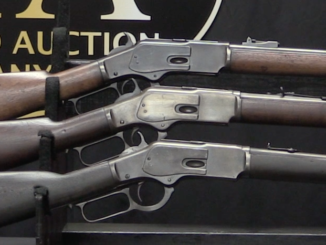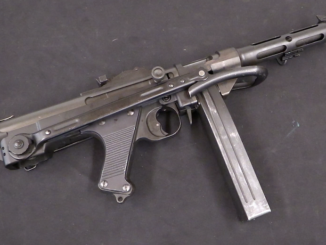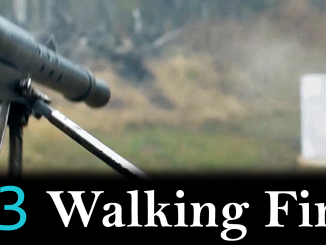The Colt 1902 Philippine Model revolver is a modified version of the Colt 1878 Double Action Army or Frontier model pistol. This was Colt’s first entry into the large-frame double action revolver market, following just after the 1877 small frame Lightning and Thunderer designs. It was a marginally successful gun for Colt, with a bit more than 51,000 sold over about 30 years. The guns were not particularly robust or reliable, compared to other options at the time.
The US Army had tested the Model 1878 in 1879, and rejected it – largely because of problems with light primer strikes. Many years later, experience in the Philippines would lead the government to seek .45 caliber revolvers for issue to the Philippine Constabulary. Colt seized this opportunity by fitting a stronger hammer spring to the 1878 revolver, and lengthening the trigger to give the shooter more leverage on the correspondingly heavier trigger. The trigger guard was also enlarged, as necessary to fit the lengthened trigger. This gave the gun a distinct look, which would become popularly known as the Alaskan Model, inferring use with gloves in cold weather. In reality, however, this design was to increase reliability with the aim of making a government sale.
The changes worked, too – the government purchased 4600 of the guns for use in the Philippines in 1902. While many assume that the .45 revolver acquired in response to the Moro fighters’ fighting spirit was the 1873 Single Action Army, it was actually the 1878/1902 (while some SAAs were put into service, this was done by individual officers, and not by government plan).




Rotating hand or lever seems double functioned; Revolving and stopping the cylnder as aligned with the barrel. A weak system by means of the lesser leverage.
The problem with the Colt Model 1892/94 .38 revolver wasn’t its caliber, it was its low muzzle energy. The .38 Long Colt round launched a 150 grain bullet at 770 F/S for 195 FPE. That’s about half the energy of the old .45 Colt revolver service load (255 grain at 855 F/S for 405 FPE), so naturally it didn’t have the same degree of terminal effect.
Of course, if you tried to bring it up to the .45’s energy level, say with a 150-grain at 1100 for 403 FPE, there’s a very good chance the M92/94 would promptly and enthusiastically blow up right in your face.
The real answer was of course something like the 9 x 19mm; a medium to high-velocity bullet in a platform that could stand the pressure. It’s interesting to note that contrary to popular belief, it was the German police, not the Reichswehr, that asked for a better cartridge in the Parabellum pistol than the 7.65mm. In their case, they concluded based on experience that a 93 grain bullet at 1220 F/S for 307 FPE wasn’t quite enough to get the job done.
The 9mm’s 124 grain at 1250 for 350 or so seems to have worked, judging from the round’s track record for the last 109 years.
cheers
eon
“The 9mm’s 124 grain at 1250 for 350”
According to https://en.wikipedia.org/wiki/.38_ACP original loading was 130 grain @ 1260 fps.
STANDARD BALLISTICS OF KYNOCH CENTRAL-FIRE METALLIC CARTRIDGES states that
·380 Long Rifle (Long Colt) loaded with POWDER: 16 grs Black, BULLET: 124 gr. Lead has has Muzzle Velocity Ft. per sec. 1125 and Muzzle Energy Ft. lbs. 348
Sadly there is no info about test barrel length.
Interestingly, according to source I read many years ago, to incapacitate smaller size deer 45FPE would suffice. But, you can say, deer is rarely on drugs.
“45FPE would suffice”
Notice that FPE index, does not include bullet shape and principle of operation, for example some bullets work on principle of tumbling and some of expanding (“mushrooming”) which will work properly if it has enough impact velocity, thus effectiveness is not linear proportional to FPE index.
Kinetic energy isn’t everything when it comes to terminal effects of relatively low velocity pistol bullets. A larger bullet means a larger permanent wound channel, which in turn means a greater likelyhood of critical organ and major artery damage, as well all faster overall bleeding even if no major artery is damaged.
.38 Long Colt has enough energy to penetrate through the torso at most impact angles at typical pistol ranges. The only possible exceptions would be lateral hits where the bullet would first have to travel through major bones of the arm or forearm. Ribs alone would not reduce penetration significantly. Neither .38 LC or .45 Colt have enough velocity to cause major hydrodynamic effects (the so called temporary cavity).Therefore, the only truly significant difference between the bullets in question is diameter, unless softpoint or other expanding ammunition is used, in which case the question of reliability of expansion is relevant. Such bullets were not used by the US Army at the time.
I would also like to point out that there is little evidence of 9mm Parabellum actually being more effective pistol cartridge than 7.65mm Parabellum. 9mm has greater bullet diameter, but only slightly, so it is probably only slightly better in practice when FMJ bullets are used. Both cartridges launch their bullets at sufficient velocity to penetrate the torso through normal clothing. Furthermore, the experiences of the the Finnish Army, which was the only major military to use both cartridged in combat extensively, do not support any kind of major difference between their efficacy.
Ian: They “made” about 17,000 Colt SAA artillerys for the Phillipines. Are you saying that they were not issued but kept in Arsenal? I don’t doubt you about the Colt DA’s but do you have a source? Got the Puckle Guns shirts….they are GREAT.
The SAAs went to the US Army. The 1902s (Colt clearing out over inventoried 1878 parts and sharing winks with the Army) was specifically intended for the Philippine Constabulary. The US Army ordered DA revolvers for them and rather than sending New Service guns Colt sent obsolescent 1878s with a 6″ barrel and the oversize trigger. It is interesting to note Frankford Arsenal also made a special load of .45 ammunition with a shorter than normal .45 Colt case specifically for these guns.
this specific pistol has been stamped with a lot of the I.O.O.F. (Independent Order of Odd Fellows). I’ve put one round through it and it shoots incredible.
I also thought the government was using the .38 Long Colt and not the .38 Smith and Wesson in their revolvers. You mentioned that the government was using .38 Smith and Wesson in their revolvers in the Phillipines.
The Colt Model 1892 New Army revolver, the later Model 1894 New Army and Navy revolver (differing in having a redesigned hand and cylinder bolt) and the Model 1905 Marine Corps version (differing in being a Model ’94 with a round butt rather than a square butt) all chambered the .38 Long Colt cartridge aka the .38 Colt Army or Navy. It was introduced with the new revolver in 1892, and is not interchangeable with the .38 Smith & Wesson cartridge which was introduced in 1876.
While post-1905 loads in the .38 LC were a 158 grain bullet at 1100 F/S for 465 FPE, these loads were intended to be used only in the later (1906) Colt Army Special revolver, which was later renamed the Colt Official Police in 1921 after being re-engineered for the .38 Smith & Wesson Special aka .38 Special cartridge in 1914. Using them in the older M1892 through 1905 revolvers was extremely inadvisable from a pressure standpoint. I believe that the .38 Special round, which has a longer case than the .38 Long Colt (1.16″ vs. 1.03″) was deliberately made that way so it couldn’t be used in a .38 LC chambered revolver, just as the later .357 Magnum case was made 1.29″ in length so it wouldn’t go into a .38 Special chamber. The pressure range goes .38 Long Colt < .38 Special < .357 Magnum, and never the trio shall meet, except maybe in the .357.
The original standard military load for the .38 LC was a 150 grain at 750 for 190 foot-pounds. Barnes (Cartridges of the World, 6th ed.) lists the maximum safe load in the older revolvers as launching the 150 grain bullet at 810 F/S for 220 FPE. I will not repeat the size of the charge of powder or type of powder he suggests, as I consider both questionable from a safety standpoint.
There may have been .38 S&W chambered revolvers used in the Philippines by u.s. or Philippine Constabulary units, but they definitely were not Colt Model 1892s or etc.
cheers
eon
“I believe that the .38 Special round, which has a longer case than the .38 Long Colt (1.16″ vs. 1.03″) was deliberately made that way so it couldn’t be used in a .38 LC chambered revolver”
False, according to https://en.wikipedia.org/wiki/Colt_M1892 which states that
“(…)Both .38 Special and .357 Magnum will chamber in Colt New Army revolvers, due to the straight walled chambers, however, this should not be done under any circumstances(…)”
eon,
I have a Colt Army Special that is chambered for the .38 Special. So marked on the barrel. These guns are a bit larger and more robust than people imagine as they are built on a frame designed for the .41 Colt. They were OK to use with all .38 Special loads including the “Super Police.” The Colt Army Special is a smokeless powder era design that can handle any factory smokeless powder loading of the cartridge marked on the barrel. I’ve seen the .38 S&W Special chambering of the Colt Army Special advertised as early as 1910. The “Official Police” was not a redesign, but a rebranding of the Army Special to reflect what turned out to be their actual position in the marketplace.
Here’s a pic of a Colt Army Special advert from Arms and the Man (predecessor to the American Rifleman) from July 21, 1910:
http://i1376.photobucket.com/albums/ah34/brian458/Colt%20Army%20Special%20Arms%20and%20the%20Man%201910-07-21_zpspyawf5l0.jpg
Heavy trigger pull, miniscule rear sight notch. Excellent!
On ballistics – does anyone have any idea if the ammo used for the 1902 was the full-length ,45 Long Colt or was the Army supply system still stocking/ issuing the slightly shorter .45 Schofield round used in both the SAA and the breaktop Smith?
Frankford Arsenal created a .45 round specifically for the 1902 and did a run or two of it. It was about mid way between Schofield and the regular army load in length and had a lighter bullet. You can still find old boxes of it at cartridge collector shows. It even has a drawing of the 1902 on the box and says specifically for the 1902 Double Action Colt. That ammo was only shipped tot he Philippine garrison.
It appears that the Colt SAA was at least widely distributed to the Phillipine Constabulary, as much as the full production run of large trigger guard DA 1878’s. These original reports of course can raise as many questions as they answer. Note the number of .41 Colt Double action revolvers. Note the distribution of Remington Shotguns (double barreled?) Here is a report of 1904. Report of July 14, 1904:
“There are, therefore, in the archipelago, exclusive of those held by American soldiers and scouts, 7,370 Springfield carbines, 6,448 Remington Shotguns, 3,989 Remington Rifles, 5,129 Colts Revolvers, double action, caliber .45; 5,634 Colt’s Revolvers, single action, caliber .45; 600 Colt’s Revolvers, double action, caliber .41 and other arms as follows: 979 rifles, 1,365 shotguns, and 3,461 revolvers. Captain Phillipines Constabulary, in Charge of Ordnance Division,…Manila P.I”
If I have read the report right, the remington rifles were Spanish Rolling Blocks purchased from the Spanish and the insurrectionists. The small amount of .30 caliber ball cartridges purchased would suggest that these Remingtons might have been rebarreled to .30-40 and issued to the constabulary? Apparently the Army the Army has the capacity to repair and refurb guns in the Phillipines as this I think is mentioned on the report. There is no question that 4,000 Springfield carbines in .45 caliber were issued to the constabulary. Eventually the constabulary would be issued special Krag carbines but this was after 1905????
I am the happy owner of a Colt M1902 and I really love it !
Hosting a blog composing facility (in a broad sense) requires unlimited space. So I suggest you to discover such web hosting (internet space provider) that provide flexibility inside your internet space.
I have one of the colt Philippines and I have to say it’s a joy to shoot and a great conversation starter. It was at one time owned by someone in the I.O.O.F and they stamped their names branches and insignia on it. Some say it devalued it and some say it made it more valuable. Not for sale so I don’t really care either way.
So many of the comments are fakes like that I hardly ever visit my webmail box anymore, hence the delay in my response. They are just scammer / spammer trying to build a fake web history so they can run scams.
Is it safe to shot a smokeless cowboy load in a mixed parts 1873 colt artillery? Serial numbers in 115xxx range 1885
In no way shape or form is it okay or smart to use smokeless powder in any weapon made of low carbon steel. Colt did not warranty their weapons as safe for smokeless powder until 1902, and even then ONLY on the guns made of high carbon steel bearing the Verified Proof (VP) mark on the trigger guard.
Thanks just checking ether black powder or buy replica to shoot. I shoot my trapdoor with cowboy loads no problem guess it can take the pressure Thanks again Asa
Mu apologies for the delay. I don’t visit admin mail that often. Most of it is just scammers from China or Pakistan offering to sell N95 clone masks or ‘genuine’ vaccine doses. LoL
Anyway for the 1902 IS Army revolvers on an 1878 frame although these weapons were never issued to actual US troops the US had Frankford Arsenal develop a special load using brass midway in length between the Schofield cartridge and the standard 1873 cartridge case. The load was 30 grains of 2F black powder and a 225 grain bullet. Original ammunition boxes for this have a picture of the 1902 and specifically state that it is for the 1902 DA Philippine Constabulary revolver only.
All of that ammunition was shipped to the Philippines and turned over to the Philippine Constabulary.
There are no replicas made of the 1878 or the US 1902 revolvers. The 1902 revolver was made by using leftover 1878 revolver parts that Colt had in inventory. Colt made those parts until 1888 when it was discontinued due to their switching over to the New Service design. This was 4 years before Colt began verifying any of their guns as being safe to use with smokeless powder. All 1878 frames and cylinders used low carbon steel.
Between 1873 and 1900 the US army changed the metal of their .45 primer cups to a harder metal. When Colt suggested to the US Army that the 6.5″ barreled 1878 be deemed suitable for the Army request for .45 DA revolvers for use in the Philippines it was discovered that as currently configured the mainspring of the revolver was not stiff enough to fire the new primers. New mainsprings were designed that could deliver enough force to fire a cartridge. However this resulted in a much stiffer trigger pull which was not acceptable to the Army. The Colt solution which the Army accepted was a longer trigger to generate more leverage. This also required an oversized trigger guard to accommodate the new trigger. That design was accepted.
[Most of those revolvers bear the inspection stamp of JTT. That is the same John Thompson who determined in the famous Thompson-Lagarde Tests (they shot a bunch of cows) .45 calibers make bigger holes than do .38s and led to the requirement that the new automatic service pistol be in caliber .45. Later in WWI Thompson helped run the huge logistic depots the US set up in France (his main contribution was overseeing the installation of wood planking on any street prone to getting muddy) so horse drawn carts could leave more quickly. After WWI when he left the Army as a General he developed the Thompson sub-machine gun and went broke trying to get someone to buy enough of them to pay his bills. He died before the US Army finally started buying them in bulk.]
Anyway, upon the gun’s arrival in the Philippines it was discovered the small statured local people did not shoot well due to the recoil of the standard .45 1873 load. For that reason Frankford Arsenal was ordered to make a quarter million reduced load cartridges (described above) specifically for the new Philippine Constabulary supplied by the US Army. Very few of those original ammunition boxes survived the Japanese occupation of the islands and the many years since shipping. Intact original boxes of that 1902 .45 ammunition often sell for more than a good condition 1902 revolver.
Hope this was interesting or helpful.